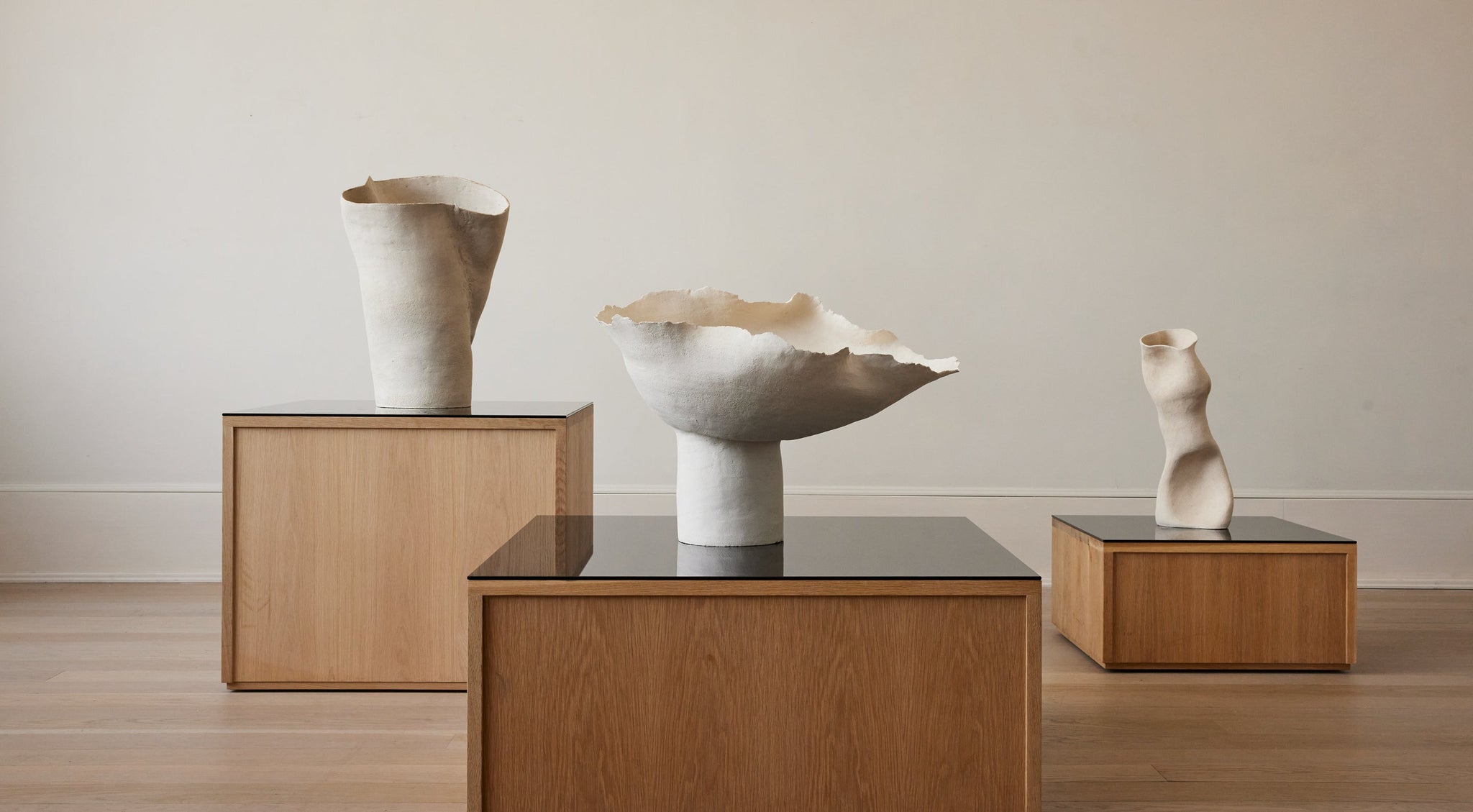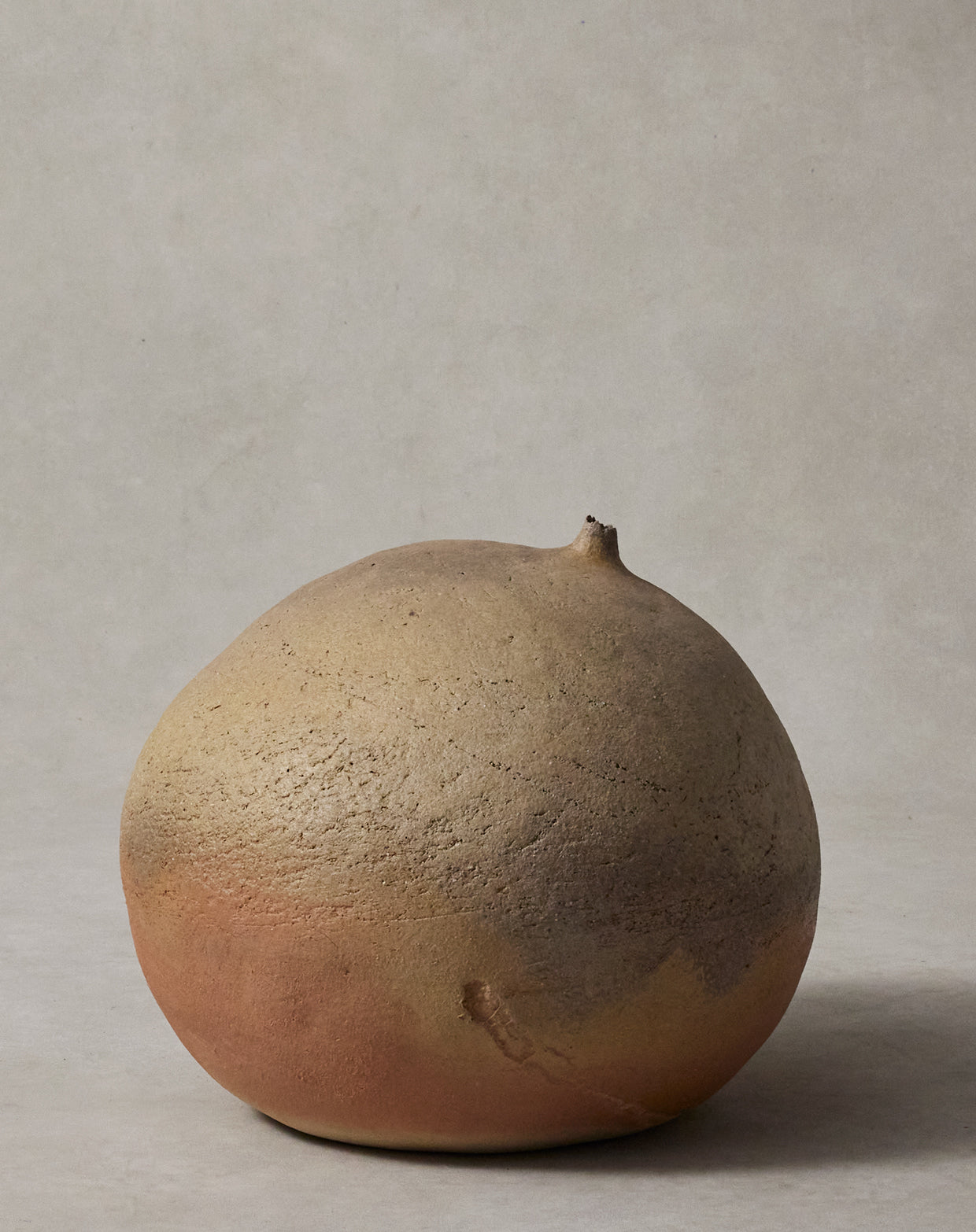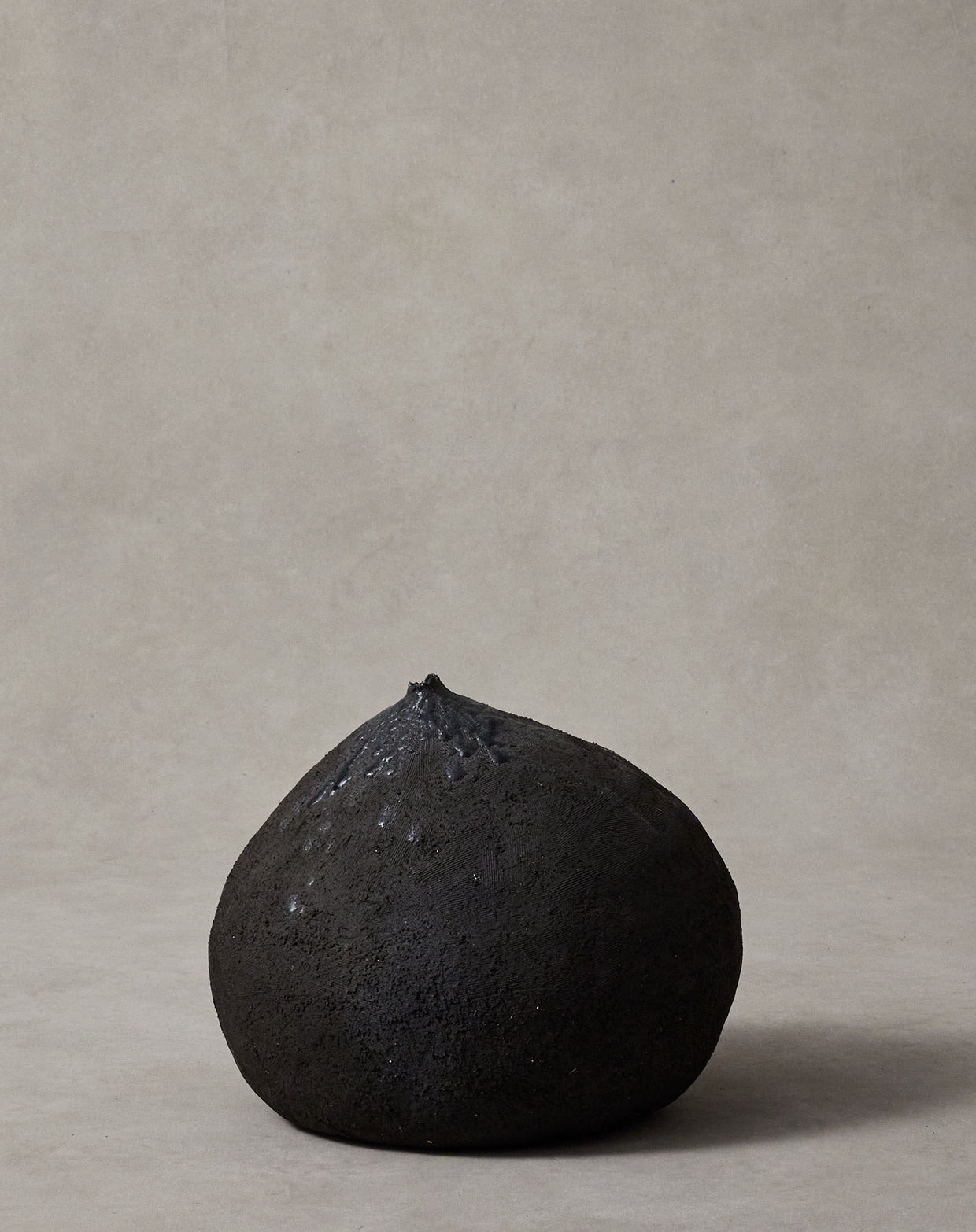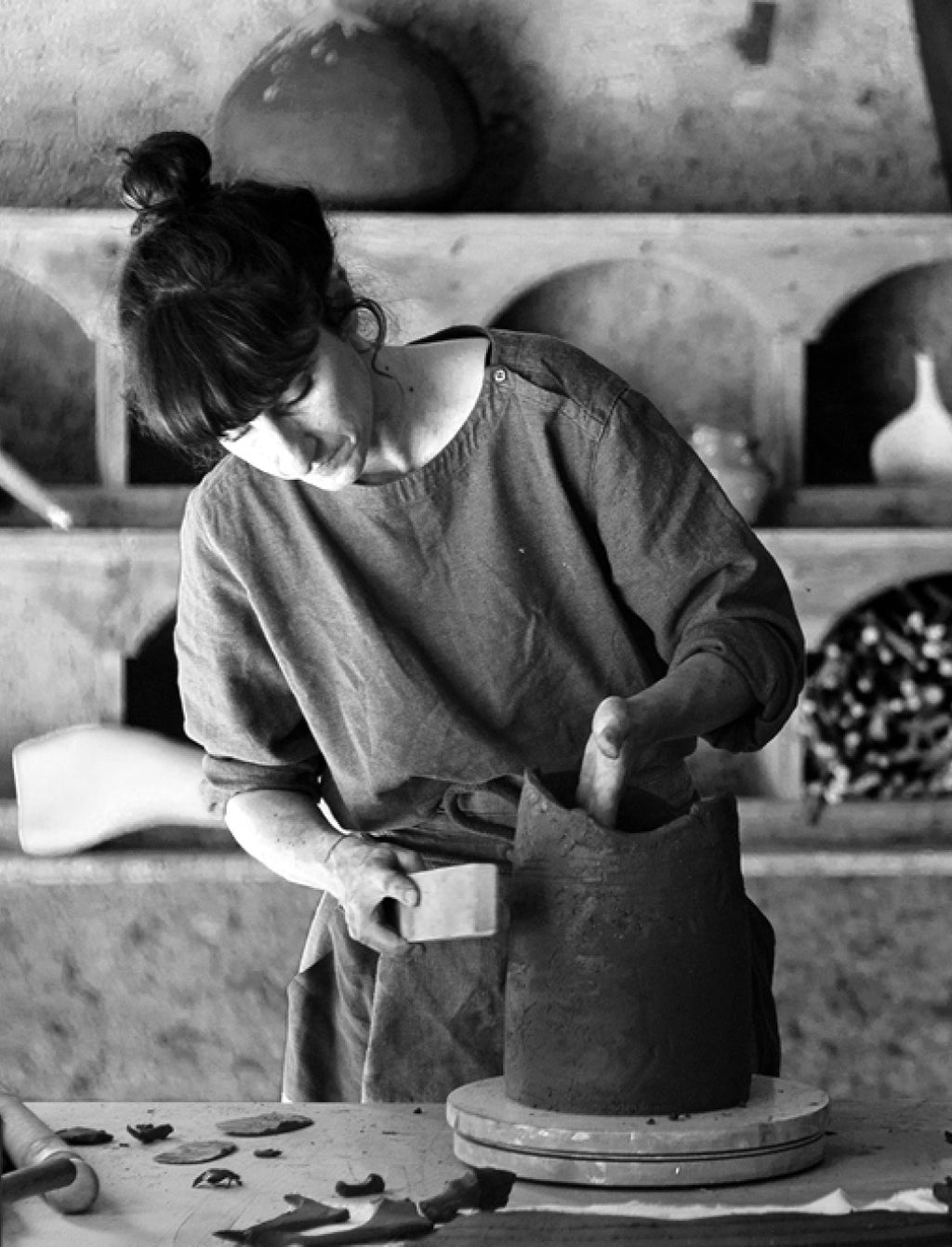LUDMILLA BALKIS
STASIS
OPENING RECEPTION
JUN 8, 2023 | 6-8PM
THREE TWO ONE CANAL STREET NEW YORK, NY 10013
INFO@RWGUILDGALLERYNY.COM
646 693 0279
PRESS RELEASE
Installation
Works
About the Show
GUILD GALLERY IS PLEASED TO PRESENT THE FIRST SOLO U.S. EXHIBITION OF LUDMILLA BALKIS, A FRENCH ARTIST WHO HAS BEEN DEFINING SUMPTUOUS MINIMALISM FOR DECADES.
A former designer for Céline under Phoebe Philo, Balkis turned to sculpture in search of a more profound connection to her surroundings and the natural rhythms of life. Utilizing her past skills and techniques, Balkis found an innate signature in manipulating clay like fabric, cutting, twisting, folding, and extracting from it a balance of delicacy and strength.

LUDMILLA BALKIS, ANIMA, 2023, BLACK SANDED STONEWARE, 14.25”H X 30.5”W 23.5”D
With this exhibition, Balkis seeks to capture stasis—a state of static balance in movement—in her sculptures. STASIS spotlights more than 20 of Balkis’ new pieces in a range of naturally colored and local Basque clay. Beginning each piece by handbuilding a solid, fixed base around emptiness, Balkis captures gesture through expressive bends, twists, and firing techniques. It is from this tension that her minimal sculptures and vessels take shape with a vigor and fragility that mirrors her natural surroundings: Pyranees mountains sculpted by time, trees serpentined by wind, rain, and light.

BALKIS ON A DAILY NATURE WALK IN BASCASSAN, FRANCE
“IT KEEPS YOU HUMBLE THAT THE MATERIAL IS NOT YOURS ANYMORE, IT’S NATURE’S WORK.”
–LUDMILLA BALKIS

THE STUDIO IN BASCASSAN, FRANCE WHERE BALKIS BEGAN HER WORK ON “STASIS”
To further engage in a dialogue with the landscape, Balkis uses geological materials foraged on her daily walks through the mountains, forest, and Atlantic coastline, augmenting the surfaces of her pieces with tree ash, stones, sticks, and minerals. Her most essential collaboration with nature occurs in firing each piece, where much like the world we live in, the elements have the final word. More than ever, nature’s perceived stillness and perpetual movement are at the heart of Balkis’s endeavor, channeled through her unequivocal devotion to minimalism.

NEW PIECES FEATURED IN STASIS SHOW THE RANGE OF BALKIS’S NATURAL CERAMIC PALETTE
INTERVIEW WITH ARTIST LUDMILLA BALKIS
By Mackenzie Wagoner
The sky is fading in French Basque Country, where Ludmilla Balkis is turning on the lights in the stonecrafted studio connected to her house. Balkis walks past the shelves of hushed ceramics that she first began creating nine years ago, illuminating their swirling movement and gentle folds with every switch she clicks. “I’m really good at working at night,” she says, taking a seat. Following her daily walks through the surrounding mountains, forest, and Atlantic coastline, on which she keeps her eyes keenly peeled for natural sculpting tools and raw materials including slab and sand, Balkis returns to her studio to sit in silence and transmit the profound intimacy with the natural world through her hands, sticks, rocks, clay, and fire. The practice requires an addictive patience paired with skills honed in her past life.
Balkis has been defining sumptuous minimalism for decades. The former designer for Phoebe Philo’s Céline turned to sculpture after the birth of her first son, looking for a creative outlet outside of fashion’s frenetic thrum. Though separate worlds, one medium informed the other. Studying alongside masters in Japan and Korea, she learned to manipulate clay like fabric, cutting, twisting, folding, and extracting from it a balance of unbelievable delicacy and unquestionable strength. This tension of “balance in movement” defines the title of her show, STASIS, comprised of more than 20 pieces hand built occasionally in two-day bursts and often in two-week stretches of negotiations with time and her surrounding elements. Most are left unglazed, finished instead by the texture of pressed bark, the bow of a found twig, a spray of wood ash, or the lingering record of a flame’s lick. Balkis joined me for a conversation on the vitality of rooting into nature, how to embody timelessness, and the art of letting go.

LEFT: LUDMILLA BALKIS, ITZALA, 2023, RED SANDED STONEWARE WITH COBALT OXIDE, 17.75”H X 10.5”W X 11.75”D RIGHT: LUDMILLA BALKIS, ARCHAIC, 2023, RED SANDED STONEWARE WITH WOOD ASH AND PORCELAIN SLIP, FIRED IN AN ANAGAMA KILN, 20.25”H X 7.25”W X 6.75”D
Mackenzie Wagoner: Tell me about how the work in STASIS began.
Ludmilla Balkis: I made the work last year while finding this equilibrium, which I had never had in my entire life. For me, this was the first group of sculptures that I have made in a way that would allow my mind to settle. The balance is not just balance in my pieces, it’s the whole balance in my life, and in the process of the pieces. The balance we can find when they go from softness to stillness, from stillness to movement. All the pieces are almost talking with one another as a landscape of my subconscious mind, let’s say.
MW: You’ve been making sculptures for nine years, but you spent a lifetime working in fabric. Does the skill set carry over?
LB: I studied a Korean technique of ceramics, where you tend to take a piece of clay and throw it several times until it's so light that it creates a kind of fluidity, almost like a fabric. I have different techniques, but this is where I tend to work. I do follow lots of masters, and they taught me so much, but I will always end up working in the way I worked with fabric. So this is interesting—the way I work is very different from everyone.
MW: What about your aesthetic—has that shifted?
LB: I wouldn’t have chosen any other brand [than Céline] because I like that idea of minimizing. Learning minimalism with Japanese masters was important to me because it goes to that point, but it also embraces imperfection—the balance between perfect and imperfect. In that way, it's very close to nature—it’s the equilibrium. It’s finding this exact tiptoeing around something that makes it timeless to me. When I would make clothes, the idea was comfort and timelessness—something that I would wear until I’m 90 years old. This is also my idea of an object.

BALKIS IN HER STUDIO

LUDMILLA BALKIS, VOID, 2023, RED SANDED STONEWARE WITH WOOD ASH, FIRED IN AN ANAGAMA KILN, 15.5”H X 8.75”W X 6.75”D
MW: Simplicity is often the hardest thing to do well. What is your approach?
LB: I tend to take off what’s unnecessary. At Céline, some clothes were very difficult to build, but they had to look very simple and very pure. This is also my approach to clay. It hast to look very light and almost like it would fade into any environment, whether it’s inside the house or in the landscape. This is why my daily walks are important. The approach of minimalism is important because the more minimal it is, the easier it can stand anywhere—not only in a museum or in a gallery. They have to be timeless, and they have to fade in a beautiful way, like a tree or a rock you might pass and not look at.
MW: Since moving to the Basque region of France, you walk every day. How does that impact your work?
LB: Living here is not being a tourist who just enjoys nature but rooting in like a tree. Daily walks in the mountains, forest, or at the sea are my kind of healing meditation. In the pace of nature, I could understand more what it was to integrate time. Something would emerge through silence and observation. The landscape is wild with movement and stillness. It can be chaotic at times. It’s strong, yet very delicate and wind shaped. The wind is a very present part of the landscape—it has shaped trees and rocks. That is reflected in my work, which looks strong yet fragile, because the edges are super thin almost like lace that could be easily broken.
MW: You also work with materials you find on your walk. What do you look for?
LB: When we moved to Basque country, my approach to work really started to shift because I began to work with more textures. It was interesting to have this relationship with nature. On my walks I might pick up sand, slab, bark, sticks, and stones to use once I’ve finished [forming] a sculpture. I like to deform the shapes or create textures with the pieces I’ve found. So it’s an evolving dialogue until the end of the piece between me, the elements, the clay, and what I found around me. This is the way I work—it’s very instinctive.

AN INTERIOR VIEW OF ILARGIA, 2023, WHITE SANDED STONEWARE WITH WHITE MATTE GLAZE AND BLACK GLAZE PARTIALLY APPLIED TO INTERIOR, 15”H X 18”W X 16”D
“I NEED TO EXPRESS [NATURE] IN MY WORK, NOT BY MIMICKING [IT], BUT BY ACCEPTING ITS CHAOS.”
–LUDMILLA BALKIS
MW: Your palette is very tight—what does that allow you to do?
LB: For me it’s to reduce the information, so the pieces stay quiet and focused on shape and movement. I mainly like to leave the clay raw to let it speak by itself. Sometimes I use slab from my walks, which has a lot of iron for a reddish finish that I often mix with wood ash, made from wood that I pick up on my walks and then burn to create ash. I rub the ash on the final sculpture when it’s still wet and let it be. Or I mix the ash with slab, which creates another color. The final finish really looks like a rock. Sometimes I add some rocks, or some thick rock-like sand. And when I use a glaze, I stay simple: matte white and black. Black, white, and earth colors, like Céline. The shapes take so much space, I have to narrow the choice of color to bring back the essential: shape and movement.
MW: How do you cement movement into your work?
LB: In Anima, On the Heavens, Haize, Openness, and Hodei, I created a round base for a fixed stillness, then created openness in movement for the opposite at the top, adding a rim almost like lace to show the delicacy of the finishing. I’ve made them with glaze, without glaze, with texture, without texture. Each sculpture is different depending on where it is and depending on the light. For me, they’re the center of the show. In other pieces, like White Dyptich, I turn a tool to slash the piece to keep the movement—the gesture—on it. The gesture is an important focus of the piece.
MW: What kind of role does your choice of kiln play?
LB: I use an electric kiln and a Japanese wood kiln, which takes six days and six nights. The fire in the anamaga creates completely different colors and the flames create movement again in the final work. It makes you humble because you feel like the material is not yours anymore. Nature decides where the work goes. It’s letting go. I feel deep inside me that the relationship between nature and my work is vitally important. I need to express that in my work, not by mimicking nature, but by accepting its chaos. It’s very Nietzschean, who would say: “Nature is chaos.” You have to accept that you’re part of it, and through chaos, you can create something really more beautiful.

BALKIS OFTEN FIRES HER WORK IN A JAPANESE WOOD ANAGAGAMA KILN, ALLOWING THE FLAMES TO PAINT THE SURFACE OF THE FINISHED WORK.






















